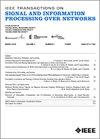Online Smooth Graph Learning From Incomplete Data
IF 3
3区 计算机科学
Q2 ENGINEERING, ELECTRICAL & ELECTRONIC
IEEE Transactions on Signal and Information Processing over Networks
Pub Date : 2025-08-01
DOI:10.1109/TSIPN.2025.3589719
引用次数: 0
Abstract
Graphs are essential for extracting crucial information embedded within structured data and are foundational tools across various fields. Predefined graphs, however, cannot adequately capture the intrinsic relationships within data, highlighting the need for learning graphs to construct meaningful representations. Particularly, graph learning is crucial in dynamic scenarios, where graphs evolve in response to streamed signals, requiring real-time adaptation through online methods. Additionally, missing values in sequential data pose challenges that necessitate signal reconstruction techniques to recover incomplete information, ensuring accurate and reliable graph inference. To address such issues, we design a novel online algorithm that achieves joint signal reconstruction and topology inference under smoothness priors. Specifically, the two sub-problems are formulated as a joint optimization task, solvable through alternating minimization. To enable efficient online graph learning with a trade-off in accuracy, the inexact proximal online gradient descent (IPOGD) is incorporated into our algorithm, and a dynamic regret analysis demonstrates a sublinear regret bound. Experimental results on both synthetic and real-world datasets validate its effectiveness in tracking slowly-evolving networks with incomplete data.基于不完整数据的在线平滑图学习
图对于提取嵌入在结构化数据中的关键信息是必不可少的,并且是跨各个领域的基础工具。然而,预定义的图不能充分捕捉数据中的内在关系,这突出了学习图来构建有意义的表示的必要性。特别是,图学习在动态场景中至关重要,在动态场景中,图会响应流信号而进化,需要通过在线方法进行实时调整。此外,序列数据中的缺失值带来了挑战,需要信号重建技术来恢复不完整的信息,以确保准确可靠的图推断。为了解决这些问题,我们设计了一种新的在线算法,在平滑先验下实现联合信号重构和拓扑推理。具体来说,这两个子问题被表述为一个联合优化任务,通过交替最小化来求解。为了使在线图学习在准确性上得到有效的权衡,我们的算法中加入了不精确的近端在线梯度下降(IPOGD),并且动态后悔分析展示了次线性后悔界。在合成数据集和真实数据集上的实验结果验证了该方法在跟踪数据不完整的缓慢进化网络方面的有效性。
本文章由计算机程序翻译,如有差异,请以英文原文为准。
求助全文
约1分钟内获得全文
求助全文
来源期刊

IEEE Transactions on Signal and Information Processing over Networks
Computer Science-Computer Networks and Communications
CiteScore
5.80
自引率
12.50%
发文量
56
期刊介绍:
The IEEE Transactions on Signal and Information Processing over Networks publishes high-quality papers that extend the classical notions of processing of signals defined over vector spaces (e.g. time and space) to processing of signals and information (data) defined over networks, potentially dynamically varying. In signal processing over networks, the topology of the network may define structural relationships in the data, or may constrain processing of the data. Topics include distributed algorithms for filtering, detection, estimation, adaptation and learning, model selection, data fusion, and diffusion or evolution of information over such networks, and applications of distributed signal processing.
 求助内容:
求助内容: 应助结果提醒方式:
应助结果提醒方式:


